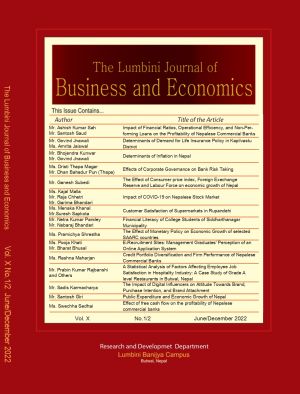The Effect of Monetary Policy on Economic Growth of selected SAARC countries
DOI:
https://doi.org/10.3126/ljbe.v10i1-2.54210Keywords:
Monetary Policy, Economic Growth, Panel Data, OLSAbstract
The study intended to examine the effect of monetary policy on economic growth of selected SAARC countries. Inorder to fulfill these objectives analysis is based on panel data over 25 years of period from 1996 to 2020 of selected five SAARC nations. Economic growth is measured by GDP per capita growth where exchange rate, inflation, broad money to GDP, external reserve are used as monetary policy variables. The Descriptive and casual relationship research design has been used using secondary data. Hausman test is run to select between the fixed and random effect model and correlation matrix is used in this study to summarize the relationship between variables. Among the variables, external reserve, broad money was found to have positive significant effect on GDP while exchange rate has negative significant effect. Also, inflation was found to have negative insignificant effect on economic growth at 5% level of significance. This study concludes that the inability of monetary policies to effectively maximize their policy objectives most of the time is due to flaws in the policy instruments used, which limits their contribution to growth even though monetary policies have made impressive contributions over the years.




